
Computer Network Topology and its Types
Definition:
The layout or the structure of any network is called as Topology.
Topologies are divided into 2 types –
- Physical Topology
- Logical Topology
• Physical Topology: –
The way devices are connected with each other in a network is called as Physical Topology.
• Logical Topology: –
The way devices are communicating with each other in a network is called as Logical Topology.
Types of Topologies:
There are 6 different types of Physical Topology –
• Bus Topology
• Ring Topology
• Star Topology
• Mesh Topology
• Tree Topology
• Hybrid Topology
Bus Topology:
Characteristics: –
• Bus Topology is a network where all the node is connected with each other with a simple common cable.
• Bus Topology, where all nodes are connected with a simple common cable, known as backbone cable.
• There is ‘T’ connecter are used to connect the branch cable with the backbone cable.
• It is mainly used in 802.3 (ethernet) and 802.4 (standard network).
• The most common access method of this topology is Carrier Sense Multiple Access).
• Here data is transmitting in single direction. No bi-directional feature is in Bus Topology.
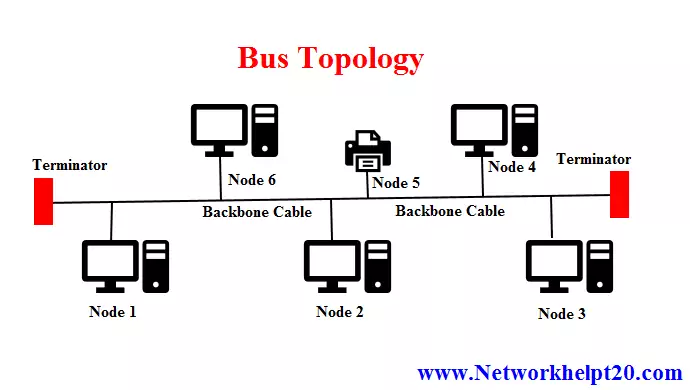
Advantages of Bus Topology: –
• It is easy to install.
• Its installation cost is low.
• It is required less cable compare to other network topology.
• It is used in small network.
Disadvantages of Bus Topology: –
• If the backbone cable fails, then the whole network shuts down.
• It has a limited length.
• It is difficult to troubleshooting.
Ring Topology:
Characteristics: –
• In this topology each device is connected in the form of a ring.
• It is physically like a bus topology but with connected ends.
• Data transmits in one direction (Uni-direction).
• The most common access method of this topology is token passing.
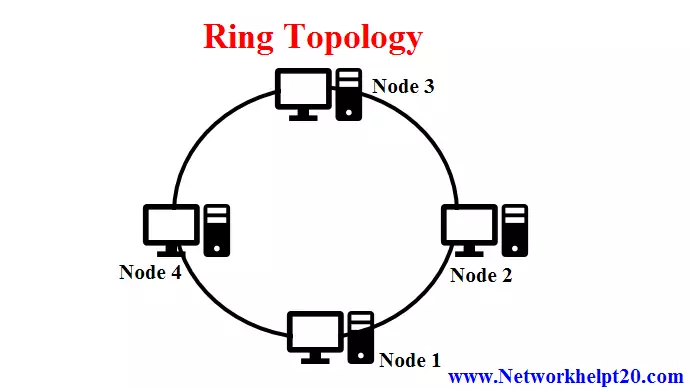
Advantages of Ring Topology: –
• In this network each & every node has equal access to resources.
• The installation cost is low.
• It is easy to install.
• It is a more reliable network because the communication system is not depending on a single computer.
• It is easy to manage to add or remove devices.
Disadvantages of Ring Topology: –
• In this network if any node breaks down then the entire network system stops working.
• Troubleshooting in difficult in this topology.
• The data transfer rate is slower than any other network.
Star Topology:
Characteristics: –
• In a Star Topology network, the system is connected to a central node called a Hub or Switch.
• Here the central node acts as a Server and the other connected node acts as Clients.
• Co-axial cable or Rj-45 cable are used to connect the computer.
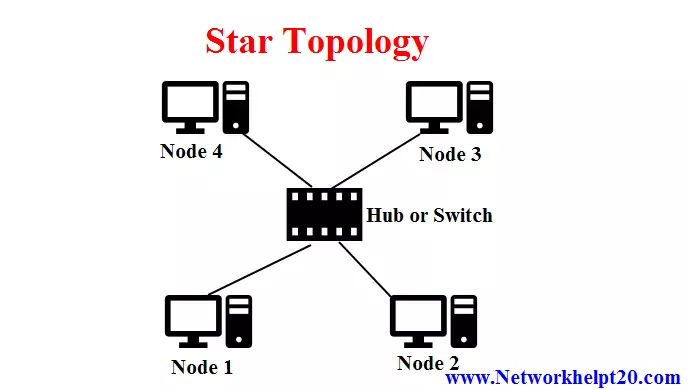
Advantages of Star Topology: –
• In this type of network, it is very easy to add or remove a node to the network system.
• It is easy to install.
• Here less amount of cable is required because every device is connected to the hub.
• It is easy to troubleshoot.
• One faulty node does not affect the rest of the network.
Disadvantages of Star Topology: –
• If the central node fails, then the entire network becomes get down.
• The central hub is expensive which makes the network more expensive.
Mesh topology:
Characteristics: –
• In this network each & every node is interconnected with each other through a dedicated Point-to-Point link.
• The internet is an example of the Mesh Topology.
• It is mainly used in WAN wireless networks.
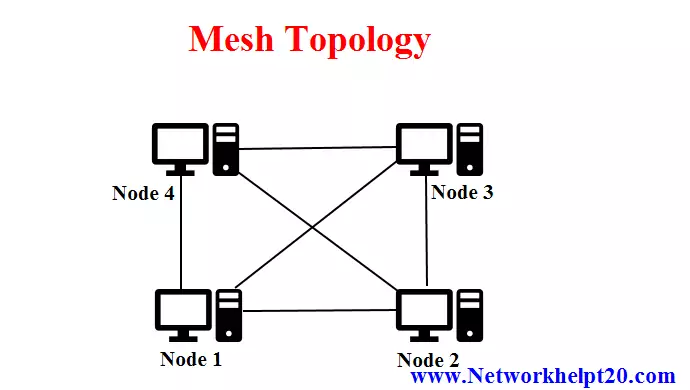
Types of Mesh Topology: –
There are 2 types of Mesh Topology –
• Full Mesh Topology:
In a Full Mesh Topology, each computer is connected to all the available computers in the network.
• Partial Mesh Topology:
In a Partial Mesh Topology, not all but certain computers are connected in the network.
Advantages of Mesh Topology: –
• Here data transfer rate is very fast than any other topology.
• Adding and removing nodes in this network could be easily.
• Here no data traffic issue because there is a dedicated link between two devices.
• It provides more security and privacy.
Disadvantages of Mesh Topology: –
• It is very expensive to install compared to other topologies.
• It is very difficult to maintain and configure.
• The cost of cable is high.
Tree Topology:
Characteristics: –
• Tree Topology combines the characteristics of Bus and Star Topology.
• A Tree Topology is a structure in which all the computer is connected with hierarchical form.
• It consists of a parent-child hierarchy.

Advantages of Tree Topology: –
• We can easily expandable in this network.
• It is mainly used in Broadband Transmission.
• It is easily managed and maintained.
• Fault finding is very easy.
Disadvantages of Tree Topology: –
• Its installation cost is very high.
• The dependency of the whole network is on a central hub.
• A new device can add, then it becomes difficult to reconfigure.
Hybrid Topology:
Characteristics: –
• It is the combination of two or more topologies.
• This network is a mixture of Peer-to-Peer and Client-Server networks.
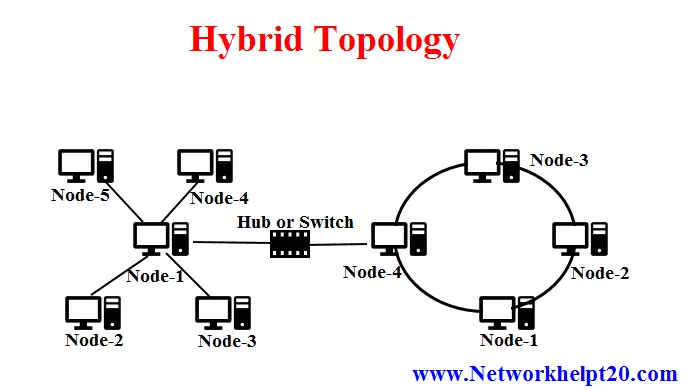
Advantages of Hybrid Topology: –
• We can easily expandable in this network.
• Fault finding and troubleshooting is very easy.
Disadvantages of Hybrid Topology: –
• Its installation process is very costly.
• It is designed to be very complex.
INTERVIEW QUESTIONS
Q. What is Node & Links?
Ans: – Any device in a network is called a Node.
A Link is a physical and logical connection between two nodes in a network.
Q. What is MAU?
Ans: – MAU (Multi-station Access Unit) is a topological Hub. But it is only used in Token Ring.
Q. What is Topology?
Ans: – The layout or the structure of any network is called as Topology.
Q. What are the types of Topology?
Ans: – Topologies are divided into 2 types – Physical Topology and Logical Topology.
Q. What is Physical Topology?
Ans: – The way devices are connected with each other in a network is called as Physical topology.
Q. What is Logical Topology?
Ans: – The way devices are communicating with each other in a network is called as Logical Topology.
Q. What are types of Physical Topology?
Ans: – There are 6 types of Physical Topologies –
• Bus Topology
• Ring Topology
• Star Topology
• Mesh Topology
• Tree Topology
• Hybrid Topology
Q. What is Bus Topology?
Ans: – Bus Topology is a network where all the nodes are connected with each other in a single common cable, also known as Backbone cable.
Q. What is ate main disadvantage of Bus Topology?
Ans: – If the backbone cable fails, then the entire network fails.
Q. What is Ring Topology?
Ans: – In this network where all nodes are connected with each other in the form of ring.
Q. What is main advantage and disadvantage of Ring Topology?
Ans: – The main advantage of Ring Topology is that each & every node has equal access to resources.
The main disadvantage of Ring Topology is that if any nodes break down then the entire network get down.
Q. What is Star Topology?
Ans: – In a Star Topology all nodes are connected with each other in a central node, called as Hub or Switch.
Q. What is main advantage & disadvantage of Star Topology?
Ans: – The main advantage of Star Topology is that one faulty node does not affect the rest of the network.
The main disadvantage of Star Topology is that if the central node fails, then the whole network becomes get down.
Q. What is Mesh Topology?
Ans: – In the Mesh Topology network each & every node is interconnected with each other in a dedicated Point-to-Point link.
Q. What is the main advantage & disadvantage of Mesh Topology?
Ans: – The main advantage of Mesh Topology is that it provides more security and privacy.
The main disadvantage of Mesh Topology is that, it is very expensive to install.
Q. What is Tree Topology?
Ans: – Tree Topology combines characteristics of Bus & Star topology.
Q. What is Hybrid Topology?
Ans: – Hybrid Topology is a combination of two or more topologies.
Q. What is Dual Ring Topology?
Ans: – A network topology in which two concentric rings connect each other, Primary ring and Secondary rings. It is a Full-duplex topology, which means one ring operates in one direction and the other ring in opposite direction.
Q. What is Token Ring technology?
Ans: – Token Ring is a computer networking technology, it was introduced by IBM in 1984 but standardized in 1989 as IEEE 802.5.
It is used in Local Area Network (LAN) in which all computers are connected in a ring or star topology and pass one or more tokens from one node to another node.
Also Read: –
• Top 160 Networking Interview Questions & Answers
• Top 115 CCNA Interview Questions & Answers
• Top 60 Linux System Administrator Interview Questions
• Top 50 Linux Interview Questions & Answers
• Computer basic Troubleshooting Interview Questions with Answers
• Computer Hardware MCQ Questions & Answers
• Computer Network MCQ Questions & Answers
• Network-Devices-Hub-Repeater-Bridge-Switch-Router-Gateways
• Computer-network-transmission-mode
• Describe straight-through and a cross-over cable
• What is Transmission Media & Types of Transmission Media
• Types of Computer Network
• What is Operating System
• Describe OSI model
• Describe TCP IP model
• Processor (CPU) in Computer
• What is BIOS
• What is Hard Disk
• RAM (Random Access Memory) definition
• CMOS Definition
• Basic Parts of a Computer
• Motherboard Definition Types Components Ports
• Components of switched-mode power supply
• Components of computer system
• Computer Input-Output Devices
• Different between Intel i-series processor Generation
• Microsoft Windows History
• Cisco Router ports Function
—O—